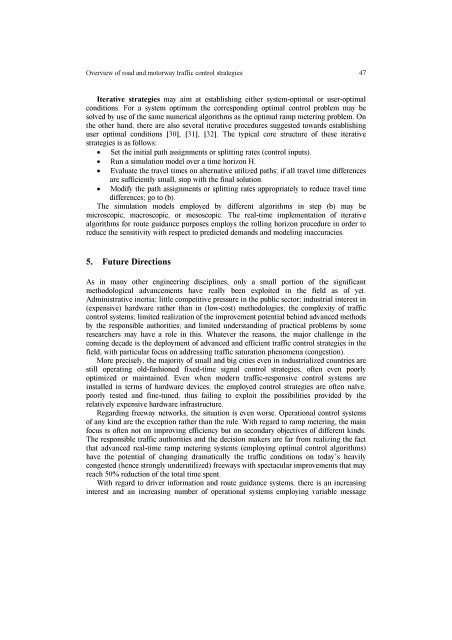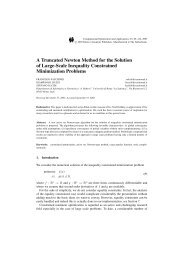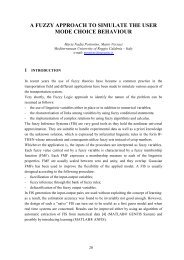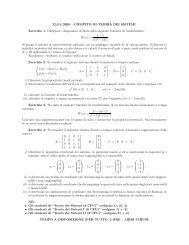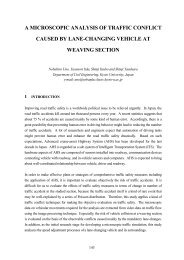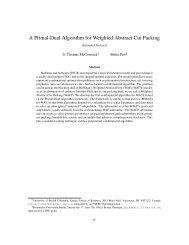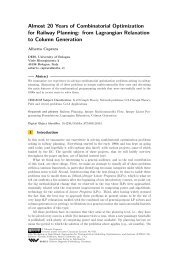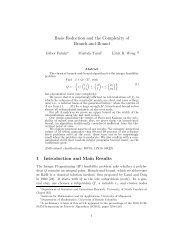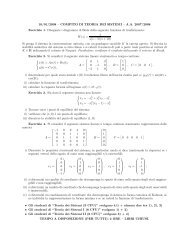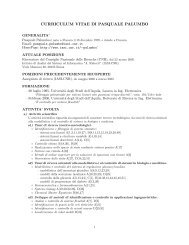OVERVIEW OF ROAD AND MOTORWAY TRAFFIC ... - Iasi.cnr.it
OVERVIEW OF ROAD AND MOTORWAY TRAFFIC ... - Iasi.cnr.it
OVERVIEW OF ROAD AND MOTORWAY TRAFFIC ... - Iasi.cnr.it
Create successful ePaper yourself
Turn your PDF publications into a flip-book with our unique Google optimized e-Paper software.
Overview of road and motorway traffic control strategies 47<br />
Iterative strategies may aim at establishing e<strong>it</strong>her system-optimal or user-optimal<br />
cond<strong>it</strong>ions. For a system optimum the corresponding optimal control problem may be<br />
solved by use of the same numerical algor<strong>it</strong>hms as the optimal ramp metering problem. On<br />
the other hand, there are also several <strong>it</strong>erative procedures suggested towards establishing<br />
user optimal cond<strong>it</strong>ions [30], [31], [32]. The typical core structure of these <strong>it</strong>erative<br />
strategies is as follows:<br />
• Set the in<strong>it</strong>ial path assignments or spl<strong>it</strong>ting rates (control inputs).<br />
• Run a simulation model over a time horizon H.<br />
• Evaluate the travel times on alternative utilized paths; if all travel time differences<br />
are sufficiently small, stop w<strong>it</strong>h the final solution.<br />
• Modify the path assignments or spl<strong>it</strong>ting rates appropriately to reduce travel time<br />
differences; go to (b).<br />
The simulation models employed by different algor<strong>it</strong>hms in step (b) may be<br />
microscopic, macroscopic, or mesoscopic. The real-time implementation of <strong>it</strong>erative<br />
algor<strong>it</strong>hms for route guidance purposes employs the rolling horizon procedure in order to<br />
reduce the sens<strong>it</strong>iv<strong>it</strong>y w<strong>it</strong>h respect to predicted demands and modeling inaccuracies.<br />
5. Future Directions<br />
As in many other engineering disciplines, only a small portion of the significant<br />
methodological advancements have really been explo<strong>it</strong>ed in the field as of yet.<br />
Administrative inertia; l<strong>it</strong>tle compet<strong>it</strong>ive pressure in the public sector; industrial interest in<br />
(expensive) hardware rather than in (low-cost) methodologies; the complex<strong>it</strong>y of traffic<br />
control systems; lim<strong>it</strong>ed realization of the improvement potential behind advanced methods<br />
by the responsible author<strong>it</strong>ies; and lim<strong>it</strong>ed understanding of practical problems by some<br />
researchers may have a role in this. Whatever the reasons, the major challenge in the<br />
coming decade is the deployment of advanced and efficient traffic control strategies in the<br />
field, w<strong>it</strong>h particular focus on addressing traffic saturation phenomena (congestion).<br />
More precisely, the major<strong>it</strong>y of small and big c<strong>it</strong>ies even in industrialized countries are<br />
still operating old-fashioned fixed-time signal control strategies, often even poorly<br />
optimized or maintained. Even when modern traffic-responsive control systems are<br />
installed in terms of hardware devices, the employed control strategies are often naïve,<br />
poorly tested and fine-tuned, thus failing to explo<strong>it</strong> the possibil<strong>it</strong>ies provided by the<br />
relatively expensive hardware infrastructure.<br />
Regarding freeway networks, the s<strong>it</strong>uation is even worse. Operational control systems<br />
of any kind are the exception rather than the rule. W<strong>it</strong>h regard to ramp metering, the main<br />
focus is often not on improving efficiency but on secondary objectives of different kinds.<br />
The responsible traffic author<strong>it</strong>ies and the decision makers are far from realizing the fact<br />
that advanced real-time ramp metering systems (employing optimal control algor<strong>it</strong>hms)<br />
have the potential of changing dramatically the traffic cond<strong>it</strong>ions on today’s heavily<br />
congested (hence strongly underutilized) freeways w<strong>it</strong>h spectacular improvements that may<br />
reach 50% reduction of the total time spent.<br />
W<strong>it</strong>h regard to driver information and route guidance systems, there is an increasing<br />
interest and an increasing number of operational systems employing variable message


